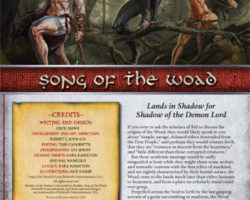Song of the Woad by Cecil Hower is a role playing game supplement published by Schwalb Entertainment for use with Shadow of the Demon Lord. The supplement is part of the Lands in Shadow series that further detail the official Urth setting.
This is a nine page PDF that is available from RPGNow for $2.49 but was purchased at the reduced price of $1.72 during a sale. Around half of the first page is an illustrations and a quarter the Credits; the rest of the supplement is content.
The supplement starts with the typical opening paragraphs on the subject. This supplement is different to many of the Lands in Shadow series, as it describes a culture and people, and one that tends to be nomadic at that, rather than a specific area.
 Born from Dreams explain how the Woad came into existence from a genie who forced itself into sleep in order to try and escape madness as it travelled through the Void. The genie’s dream created a real, tiny realm in the Void, one inhabited by living animals, but the madness spread into the realm. When the genie finally lost its grip on its sanity as its realm fracture, its dying scream shattered the realm into tiny pieces, one of which landed on Urth. This piece still had some of the created animals on it and, when they interacted with Urth’s field of magic, the animals who survived were transformed into human-like beings. The Woad are therefore creatures who look human but are not actually human.
Born from Dreams explain how the Woad came into existence from a genie who forced itself into sleep in order to try and escape madness as it travelled through the Void. The genie’s dream created a real, tiny realm in the Void, one inhabited by living animals, but the madness spread into the realm. When the genie finally lost its grip on its sanity as its realm fracture, its dying scream shattered the realm into tiny pieces, one of which landed on Urth. This piece still had some of the created animals on it and, when they interacted with Urth’s field of magic, the animals who survived were transformed into human-like beings. The Woad are therefore creatures who look human but are not actually human.
The Woad came into conflict with the First People and their ferocity in battle made them victorious. As the First People learned the skills of civilisation, they forced the Woad out using disciplines and armies. The Woad came into conflict with beastmen in their new areas, and the two fought due to a complete hatred of the other. The Woad lost and returned to their former lands, which had since fallen under the sway of the Witch-King. The Woad allied with the Kalasans to defeat the Witch-King’s forces, but after victory the Kalasans, believing the Woad to be dangerous savages, turned on their former allies. Of the several hundred initial Woad tribes, all of which were associated with animals, only thirteen survive, and some of those barely.
Today, the Woad survive as nomadic hunters and gatherers and consider any land they occupy to be theirs. Their unchanging beliefs bring them into frequent conflict with the civilised nations. The Woad also do not believe in any deity they cannot see. They instead believe in the Field Without End, which they can see, an afterlife that is supported by the beliefs of the Woad, one in the sky above Urth and one from which the Void can be seen.
The Thirteen Tribes gives an overview of the peculiarities of each of the thirteen surviving tribes, each of which is named after a single animal. The tribes spread across the area of the Empire and the Confederacy of Nine Cities. One tribe was nearly wiped out by the jotun and today is a hybrid race of Woad and jotun; another disappeared into the Desolation and may now have returned.
Woad Characters has details for creating such, with information on Woad Priests and what benefits the different tribes give to characters. There is also a new Woad background table and an Expert path, Spiritsinger.
Song of the Woad in Review
The PDF lacks bookmarks and, although it is comparatively short, these would have been useful. Navigation is poor. The text maintains a two column full colour format and appeared to be free of errors. There are several custom colour illustrations. Presentation is very good.
This is, as mentioned, an unusual entry in the Lands in Shadow series, covering as it does a culture rather than a realm. The Field Without End could perhaps qualify as a realm, but it isn’t greatly detailed. The supplement does provide options to play characters who are almost human, but are not actually human.
There are no explicit adventure hooks listed but the various tribe entries each have potential ones in their descriptions. Song of the Woad would perhaps be better considered to be a racial book for Urth rather than one detailing a place and it can be found by clicking here.

Leave a Reply